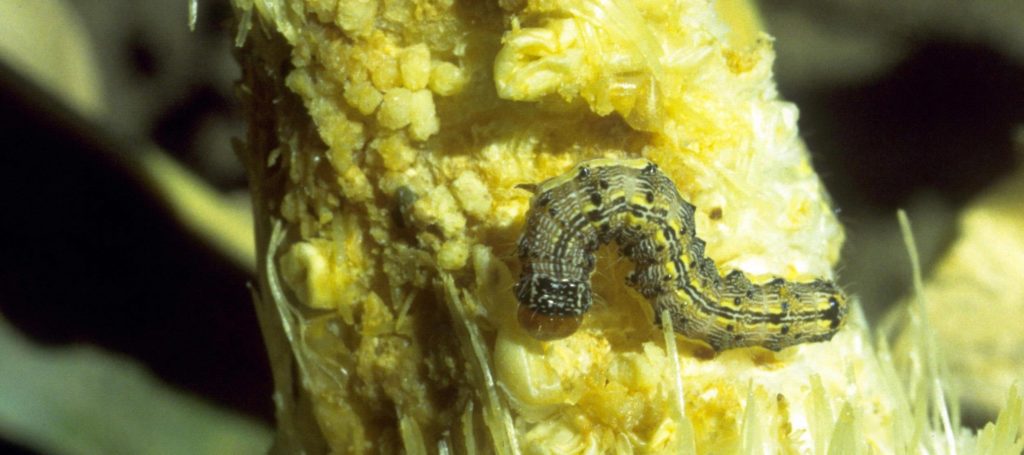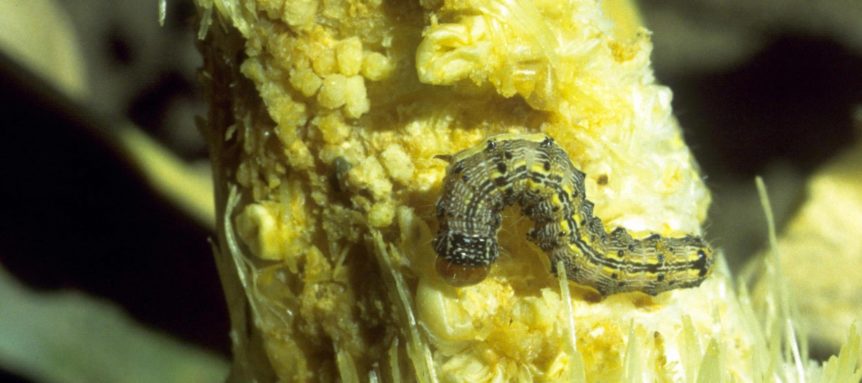
Photo by Eugene Nelson
By Frank Giles
Georgia is the third-largest fresh market producer of sweet corn in the United States with about 27,000 acres per season. Sweet corn is also the second-most valuable vegetable crop produced in the state.
Consumers love sweet corn, but so do corn earworms (CEW), which have become increasingly problematic. With virtually zero tolerance for CEW in fresh sweet corn from marketers, the pest is a top grower concern.

“CEW is a fairly consistent pest, particularly in sweet corn. Populations are relatively low in spring corn, but are treatable, because the tolerance for damage is very low,” said Alton “Stormy” Sparks, a professor of entomology with the University of Georgia (UGA). “It can be ridiculous in summer corn … but can drop off in fall corn.”
Wes Briggs, a South Georgia crop consultant, agrees. “The biggest issue my growers are seeing right now by far is the escape of CEW. It is getting to a point where if you are going to plant sweet corn on a large scale, you need to have a tray-pack option,” Briggs said. “Anything over 2% ear damage will be rejected. Some fields have been lost to the pest.”
Resistance Concerns
Briggs said the frequency at which growers must treat for CEW likely is leading to resistance. He said in this past summer’s crop, he had some fields running 20% escape of CEW.
“That is a major escape. So, we are dealing with an emerging level of resistance, but we are not entirely sure exactly to which compound because so much is being applied to try to control the problem,” Briggs said. “But there is some evidence it could be, at least in part, pyrethroids.”
Phillip Roberts, an Extension entomologist with UGA, has been tracking pyrethroid use and potential resistance. Pyrethroids are a key component of CEW control in sweet corn because they have been effective and are less expensive. Roberts has monitored CEW moths for decades with the vial technique, which has shown a steady decline in pyrethroid efficacy over the last few years. A bioassay with larvae collected from sweet corn in 2023 showed about 50% control with pyrethroids.
CEW lays eggs directly on silks, and larvae hatch and enter the silk channels almost immediately. The pest cannot be controlled once inside the silk channels. Sparks said frequent insecticide sprays are the only practical method of control.
Pesticide Products
“There are multiple newer insecticides that are highly effective against CEW. Unfortunately, they are also more expensive,” Sparks said. “The biology of this pest and its interaction with the crop make frequent insecticide applications a necessity, even with products that have potential long residual control. Basically, the long residual is not a benefit in this system. They fit in well with a rotation program with pyrethroids, but if pyrethroids are lost, the newer products can’t easily replace them due to cost and restrictions on number of applications that can be made per crop.”
“There’s just not enough products to get you through a crop when the pressure is high,” Briggs adds.
Other Management Options
Sparks said probably the best approach is processing CEW-damaged corn through tray-pack facilities. The damage is chopped off, packed and ready for the market.
“As with many of our pests, CEW are somewhat seasonal. Not planting during periods of high pest pressure is a potential approach, and some growers have started doing this,” he said. “But market windows rule the world in vegetable production, and this might not always align well with that.”
There have been some Bacillus thuringiensis (Bt) sweet corn varieties developed. Some Bt strains work well against CEW but have not been pursued because of retail and consumer resistance to genetically modified organisms. No Bt sweet corn varieties are currently in cultivation.










